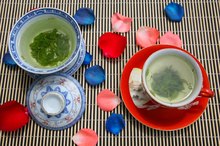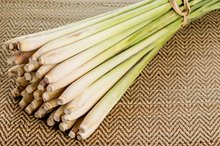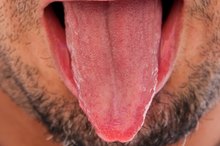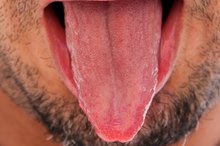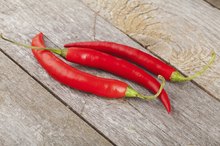Tannins & Jaw Pain
Tannins are plant compounds that display a variety of properties, some of which are beneficial and others that lead to problems. Tannins cause red wine and black tea to be astringent and bitter, which may affect your saliva glands and trigger jaw pain. On the other hand, tannins display mild anti-inflammatory properties and they can quickly reduce bleeding, which is beneficial in healing dental trauma, a common cause of jaw pain. Consult with your doctor or dentist if you experience unexplained jaw pain that lasts for more than a few days.
Tannins
Tannins are commonly found in unripe fruit, grapes and tea leaves. Plants use the tannic acid in tannins to regulate growth and deter predation from animals and insects. The astringency of tannic acid is what causes the dry and puckered feeling in your mouth after drinking red wine, black tea or juice from unripe fruit. As fruit and wine age, the tannins break down, which leads to less bitterness and astringency. Tannins have medicinal benefit also, as they display mild antimicrobial and anti-inflammatory properties, according to “Natural Standard Herb & Supplement Reference: Evidence-based Clinical Reviews.” Tannins also cause constriction of blood vessels, which is helpful for healing wounds 1.
- Tannins are commonly found in unripe fruit, grapes and tea leaves.
- The astringency of tannic acid is what causes the dry and puckered feeling in your mouth after drinking red wine, black tea or juice from unripe fruit.
Tannins as a Cause of Jaw Pain
Essiac Tea Side Effects
Learn More
The bitterness and astringency of tannins cause a rapid increase in saliva secretion from the salivary glands, according to “Principles and Practice of Phytotherapy: Modern Herbal Medicine.” The main salivary glands in your mouth are the parotid glands, the submandibular glands and the sublingual glands 2. The parotids are the largest salivary glands and they are located directly over the hinges of the jaw, also called temporomandibular joints. Sudden stimulation of the parotid glands, either by ingesting tannins or from a cold draft, can lead to painful sensations and jaw muscle contraction or spasm. Jaw pain from consumption of tannins is usually mild to moderate in intensity and short-lasting. A similar phenomenon is experienced with drinking fresh, unsweetened lemon juice.
- The bitterness and astringency of tannins cause a rapid increase in saliva secretion from the salivary glands, according to “Principles and Practice of Phytotherapy: Modern Herbal Medicine.” Sudden stimulation of the parotid glands, either by ingesting tannins or from a cold draft, can lead to painful sensations and jaw muscle contraction or spasm.
Tannins for Jaw Pain
A common cause of jaw pain is dental trauma, either accidentally or as a consequence of dental procedures. Lacerations, inflammation and infection are common consequences of dental trauma, which you can combat with the application of tannin-rich compounds. For bleeding, inflammation and pain inside your mouth, applying a cool tea bag helps because tannic acid constricts blood vessels and displays mild anti-inflammatory and antibacterial properties.
Rich Sources of Tannins
What Are the Benefits of Mint Green Tea?
Learn More
The best known sources of tannins are black tea leaves and red wine. Natural apple, grape, cranberry and pomegranate juices all contain high amounts of tannins. Sometimes tannic acid is added to juices and ciders to create more astringent tastes. Other fruits notably rich in tannins are persimmons and strawberries. Tannins are also found in beer, especially the bitter varieties.
- The best known sources of tannins are black tea leaves and red wine.
- Other fruits notably rich in tannins are persimmons and strawberries.
Related Articles
References
- Natural Standard Herb & Supplement Reference: Evidence-based Clinical Reviews; Catherine E. Ulbricht and Ethan M. Basch
- Principles and Practice of Phytotherapy: Modern Herbal Medicine; Simon Mills and Kerry Bone
- Delimont NM, Haub MD, Lindshield BL. The impact of tannin consumption on iron bioavailability and status: a narrative review. Curr Dev Nutr. 2017;1(2):1-12. doi:10.3945/cdn.116.000042
- Khasnabis, J, Rai C, Roy A. Determination of tannin content by titrimetric method from different types of tea. Journal of Chemical and Pharmaceutical Research. 2015;7(6):238-241.
- Joubert, E, de Beera D. Rooibos (Aspalathus linearis) beyond the farm gate: From herbal tea to potential phytopharmaceutical. South African Journal of Botany. 2011;77(4):869-886. doi:10.1016/j.sajb.2011.07.004
- Hurrell RF, Reddy M, Cook JD. Inhibition of non-haem iron absorption in man by polyphenolic-containing beverages. Br J Nutr. 1999;81(4):289-95. doi:10.1017/S0007114599000537
- Mennen L, Hirvonen T, Arnault N, Bertrais S, Galan P, Hercberg S. Consumption of black, green and herbal tea and iron status in French adults. Eur J Clin Nutr. 2007;61(10):1174-9. doi:10.1038/sj.ejcn.1602634
- Ahmad Fuzi SF, Koller D, Bruggraber S, Pereira DI, Dainty JR, Mushtaq S. A 1-h time interval between a meal containing iron and consumption of tea attenuates the inhibitory effects on iron absorption: a controlled trial in a cohort of healthy UK women using a stable iron isotope. Am J Clin Nutr. 2017;106(6):1413-1421. doi:10.3945/ajcn.117.161364
- Morck TA, Lynch SR, Cook JD. Inhibition of food iron absorption by coffee. Am J Clin Nutr. 1983;37(3):416-420. doi:10.1093/ajcn/37.3.416
Writer Bio
Sirah Dubois is currently a PhD student in food science after having completed her master's degree in nutrition at the University of Alberta. She has worked in private practice as a dietitian in Edmonton, Canada and her nutrition-related articles have appeared in The Edmonton Journal newspaper.

